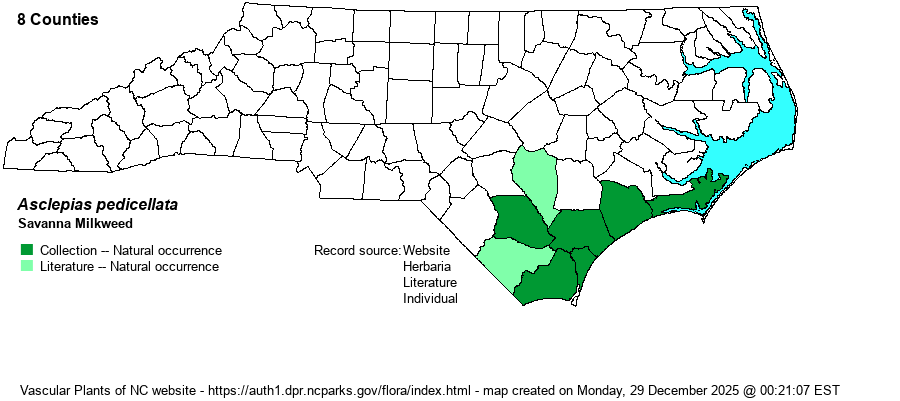| Author | Walter | |
| Distribution | Limited to the southeastern part of the Coastal Plain, ranging north to Carteret and Sampson counties, and west only to Bladen and Columbus counties.
This is a Southern Coastal Plain species, ranging north to southeastern NC, and south to southern FL and west to the FL Panhandle. | |
| Abundance | Generally rare over its range in the state, but uncommon in a few well-managed natural areas in coastal counties. It is listed as State Special Concern. Despite it being state-listed, there are enough records in the NCNHP database for it to be State Ranked as S3 instead of S2, further indicating that it is not rare in a handful of sites toward the coast. | |
| Habitat | This is a species of moist to mesic Longleaf Pine (Pinus palustris) habitats -- mostly in the drier portions of pine savannas, but also present in pine flatwoods. |
| Phenology | Blooms from May into July, and fruits in July and August. | |
| Identification | This is the smallest/shortest of the state's milkweeds, easily overlooked amid other herbaceous vegetation in its grassy savanna and flatwood habitats. It has an unbranched stem, only about 8 inches tall. There are only a few pairs of opposite leaves along the stem, somewhat linear to narrowly elliptic and about 1.5 inches long and about 1/5-inch wide, often angled upwards. There are one to several clusters of flowers, each cluster quite loose and with just a few flowers in each. Unlike with our other milkweeds, the corolla (petals) are erect and pressed against the outside of the corona, with all parts being a greenish-yellow, and the flowers are about 2/3-inch tall/long. Without the flowers it would hard to spot the plants, and even if seen, it would be difficult to assign the mystery plant to a milkweed, unless you were to pick a leaf and see the white milky sap. Even when in bloom, the clusters of at most 10-15 flowers (in total) are not visible at long ranges, but up close (within 10 feet) you should notice this quite unusual milkweed (with the odd flower structure) when in bloom. You have a fair chance of seeing this species if you visit a few of the well-managed (with prescribed burns) savannas in the summertime. | |
| Taxonomic Comments | None
| |
| Other Common Name(s) | Stalked Milkweed. Most references spell the common name as Savannah Milkweed. Assuming this first name is not referring to the city in Georgia, this website, as well as most botanical and ecological references, spell the natural community/habitat as "savanna". | |
| State Rank | S3 | |
| Global Rank | G4 | |
| State Status | SC-V | |
| US Status | | |
| USACE-agcp | FACW link |
| USACE-emp | | |

